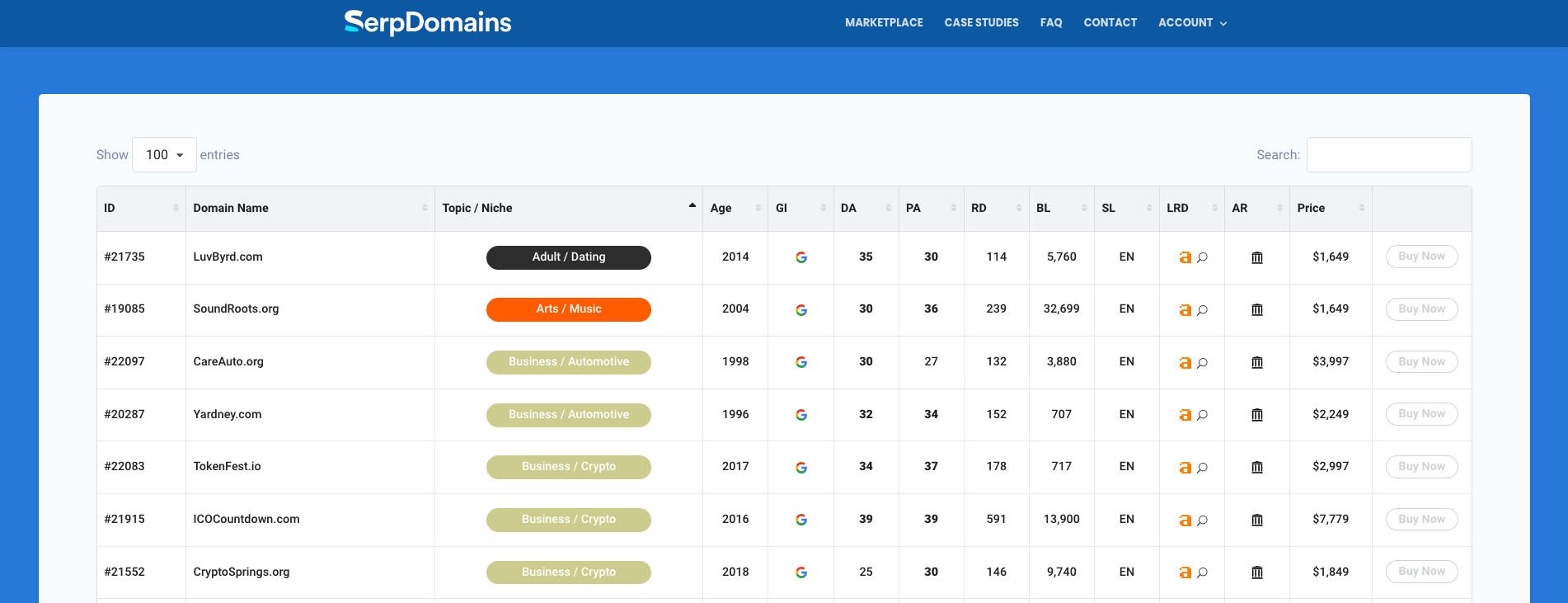Table of Contents
- Understanding the Value of Aged Domain Names in SEO Strategy
- Key Factors to Consider When Purchasing Aged Domains
- Evaluating Domain Authority and Backlink Profiles
- Where to Look for Reliable Aged Domain Listings
- Maximizing Your Investment: Effective Strategies for Aged Domains
- Q&A
- To Wrap It Up
Understanding the Value of Aged Domain Names in SEO Strategy
Aged domain names offer a myriad of benefits for those looking to enhance their SEO strategy. One of the primary advantages is authority. Older domains often come with a history of backlinks and established credibility, which search engines like Google favor. This inherent authority can provide a head start in rankings over newer domains. Additionally, an aged domain may already have indexed pages, meaning you can begin to attract organic traffic almost immediately after acquisition.
Another compelling factor is the previous content associated with the domain. If the domain has been used for relevant content in the past, it can carry forward some of that relevance, which might benefit your new content strategy. This can lead to enhanced rankings for targeted keywords. Moreover, if the domain previously held a strong position in its niche, its existing audience can be a springboard for your new website. Utilizing the historical data associated with these domains allows you to analyze their performance and tailor your approach effectively.
Lastly, acquiring an aged domain can be a strategic move in terms of branding. A name that resonates with an audience and has been previously active can boost recall and trustworthiness. When purchasing an aged domain, consider the following criteria to optimize your selection:
- Backlink Profile: Analyze the quality and quantity of backlinks.
- Keyword Relevance: Ensure the domain aligns with your niche keywords.
- History of Penalties: Check for any past penalties that could harm SEO performance.
- Traffic Trends: Review historical traffic data to evaluate potential.
| Criteria | Importance | Scoring |
|---|---|---|
| Backlink Profile | High | 1-10 |
| Keyword Relevance | High | 1-10 |
| History of Penalties | Critical | N/A |
| Traffic Trends | Medium | 1-10 |


Key Factors to Consider When Purchasing Aged Domains
When diving into the world of aged domains, several critical factors can significantly influence your purchase decision. One of the most important considerations is the domain’s history. It’s essential to analyze past ownership, usage, and any previous penalties from search engines. Websites that have been used for spamming or malicious activities can have lingering negative effects on your SEO efforts. Use tools like Wayback Machine and domain history checkers to ensure the domain’s previous activities align with your intended use.
Another key element is assessing the SEO metrics associated with the domain. Look into the Domain Authority (DA) and Page Authority (PA), which can give you a snapshot of its potential SEO strength. A domain with established backlinks from reputable sources can provide a significant boost to your own website’s ranking. It’s also beneficial to check the current traffic levels; a domain with steady visitors indicates a healthy online presence, which can be advantageous for your new venture.
consider the relevance of the domain to your current or planned content. The domain name should resonate with your target audience and reflect the niche or industry you operate within. This alignment not only aids in SEO but also helps in building credibility among visitors. A quick keyword analysis can guide you in identifying whether the domain aligns with popular search queries related to your business. prioritizing these factors can simplify your decision-making process and ensure you choose a domain that contributes positively to your online strategy.


Evaluating Domain Authority and Backlink Profiles
When searching for aged domain names, it’s imperative to assess the Domain Authority (DA) of potential purchases. Domain Authority is a metric developed by Moz that predicts how well a domain will rank on search engines. A higher DA indicates a greater likelihood of ranking well, which can significantly impact your online visibility. Consider the following factors when evaluating DA:
- Score Ranges: DA scores range from 1 to 100, with higher scores correlating with increased credibility.
- Market Comparison: Compare the DA of your target domain against competitors in your niche.
- Growth Trends: Analyze the historical DA trends; a steadily rising DA may signal a domain on the path to improvement.
In addition to checking DA, examining the backlink profile of a domain is equally crucial. A robust backlink profile enhances your domain’s credibility and influence. Pay attention to the following elements:
| Backlink Quality | Domain Relevance | Anchor Text Diversity |
|---|---|---|
| Evaluate the trustworthiness of linking sites, favoring those with high DA. | Ensure backlinks originate from domains related to your industry. | Look for varied anchor text to enhance natural link building. |
Furthermore, a comprehensive analysis of both DA and backlinks enables a well-informed decision when acquiring an aged domain name. Tools such as Ahrefs and SEMrush can assist in gathering crucial data points about these metrics, ensuring you choose a domain with not only potential but also a solid foundation for growth. Assessing these characteristics will ultimately lead you to a domain that aligns with your strategic goals.


Where to Look for Reliable Aged Domain Listings
When diving into the world of aged domain names, it’s essential to source them from platforms that ensure reliability and validity. First and foremost, consider specialized marketplaces dedicated to domain trading. Websites like AgedDomains.com and DomainHunterGatherer.com focus exclusively on aged domains, offering detailed metrics such as Domain Authority (DA), Page Authority (PA), and backlink profiles. These metrics are crucial for evaluating the potential SEO benefits of a domain before making a purchase.
Another valuable resource is online communities and forums that cater to domain investors and webmasters. Platforms such as NamePros and DNForum not only allow you to discover aged domain listings but also provide insights from experienced members on the pros and cons of specific domains. Engaging with these communities can lead to exclusive offers and insider knowledge on the best practices for domain investment.
Lastly, don’t underestimate the power of auction sites. Websites like Sedo and Auction.com host regular domain auctions that often feature high-quality aged domains. Here, you can filter results based on age, price, and other critical factors. Familiarizing yourself with the bidding processes and setting price alerts can help ensure you don’t miss out on valuable domain opportunities.


Maximizing Your Investment: Effective Strategies for Aged Domains
When it comes to leveraging aged domains for your investment strategy, understanding their inherent value is crucial. Aged domains often come with established authority and existing backlinks, which can dramatically accelerate your website’s SEO. This advantage means you can save time on building credibility from scratch. By focusing on domains that have relevant content history and a clean link profile, you ensure that your investment pays off in the form of better search engine rankings and an immediate audience pull.
To maximize the potential of your aged domain, consider employing these tactics:
- Research Historical Performance: Use tools like Wayback Machine to visualize past content and traffic patterns.
- Assess Backlink Quality: Utilize tools such as Ahrefs or Moz to evaluate the domains pointing to your aged domain.
- Optimize Existing Content: Update the old content with current information and SEO techniques while preserving relevant historical data.
- Integrate with Social Media: Create social media profiles that reflect the aged domain’s theme or niche to engage with a broader audience.
Additionally, consider creating a targeted plan to enhance your domain’s visibility. A simple table can help outline your strategy:
| Strategy | Description | Expected Outcome |
|---|---|---|
| Content Audit | Review existing content for relevance and quality. | Improved user engagement and SEO rankings. |
| SEO Optimization | Implement on-page SEO practices, including keyword integration. | Higher visibility in search engine results. |
| Outreach Campaign | Contact websites for guest posting and backlink opportunities. | Increased domain authority and referral traffic. |
Q&A
Q&A: Understanding Aged Domain Names
What are aged domain names?
Aged domain names are web addresses that have been registered for a significant amount of time—often several years—before being put up for sale. These domains may have accumulated backlinks and historical traffic, enhancing their potential value in terms of SEO and online presence.Why should I consider buying an aged domain name?
Purchasing an aged domain can provide several benefits. They often come with established authority, already have existing backlinks, and possess a history that can give your new website a leg up in search engine rankings. It can also save you time in building a reputation from scratch.How can an aged domain name impact SEO?
Aged domains typically carry more trust and authority in the eyes of search engines like Google. This can lead to better rankings for your website, as they may already have built-in credibility and traffic. However, it’s crucial to ensure the domain has a clean history without penalties before making a purchase.What should I look for when buying an aged domain name?
When searching for a quality aged domain, pay attention to several key factors:- Domain History: Use tools like Wayback Machine or other domain history checkers to see how the site was previously used. Ensure it hasn’t been associated with spam or unethical practices.
- Backlink Profile: Analyze the backlink profile using tools like Ahrefs or SEMrush to ensure the links are from reputable sources and relevant to your niche.
- Domain Authority (DA): A higher DA indicates a more established domain, which can influence your site’s ranking potential.
- Traffic Statistics: If available, review historical traffic data to understand how much traffic the domain received prior to the sale.

